This article needs additional citations for verification .(August 2014) |


Passing is the act of juggling between two or more people. It is most commonly seen as a subset of toss juggling.
This article needs additional citations for verification .(August 2014) |


Passing is the act of juggling between two or more people. It is most commonly seen as a subset of toss juggling.
Passing can be performed with three or more juggling props but is most commonly performed with six objects such as balls, rings or clubs. "This is the basic part of team juggling and it requires two pretty smooth jugglers." [1] Jugglers can perform passing one person standing behind the other, back to back, or side by side but the most usual stance is where the jugglers face each other. [2]
Clubs are the prop of choice for passing because of the larger surface area available for catching (most often the handle), the variety of possible tricks that can be performed and the higher visibility of the props for an audience. Rings are sometimes chosen for numbers passing because of their light weight and reduced chance of collisions in the air during a passing pattern. Balls are not commonly used for passing with the exception of beginners and for bounce juggling passing.
Passing technique varies depending on the prop being used and the position of the jugglers. The standard passing pattern, where the jugglers face each other and are each juggling three props requires a high degree of competence in the solo juggling of that prop. This standard pattern can be described as the props travelling in a rectangle or box shape. Throws across the short end of the box are self throws by each juggler and throws to the other person are parallel throws to the other person. Throws from one juggler to the other are by convention usually thrown from the right hand and caught by the other juggler with the left hand. The tempo of the throws to the other juggler are usually a two count: that is a juggler will throw one prop to themselves from their right hand and then the next prop in the right hand to the other juggler. This is sometimes called every others. [3] The throwing and catching technique for each type of prop is specific to that type of prop.
Beginners usually start with ball passing but often move on to ring and then club passing. Club passing is the most popular because the props allow for a greater latitude in where they are caught, the range of tricks available are much greater than other props and the patterns available are more visual.
A passing pattern is a sequence of throws and catches using a certain number of props which is repeated continuously. An example would be the standard 6 club passing pattern between two jugglers with the throws on a two count tempo. Passing patterns, however, vary in complexity from the simple: where only two jugglers pass three objects (usually three clubs which is called 'running three'), to many jugglers passing numerous clubs in complex patterns. Patterns differ from tricks which are instead a throw or catch which is different to the throws and catches within a pattern. An example would be where a single prop is thrown high to the other juggler at the correct time so that it the other juggler can catch it in the space available and the jugglers then return to the pattern they were juggling.

A basic variation in the pattern depends on how often the "self throw" is replaced with a pass. For practice, Besmehn recommends what may be called 'six-count': "Use four balls of one color and two of another color...every time an odd-colored ball reaches your right hand, pass it." [5] Klutz recommends the same pattern: "It helps ... if one of you counts out loud every time a toss leaves your right hand[s] ... On a pre-arranged number, say three [six beats], instead of tossing across to your own left hand, throw your bag ... over to your friend's left hand." [1] Siteswap: <333333p|333333p>
Other popular patterns are;

There are many tricks that can be performed over the pattern, including varying the throwing method (under the leg, behind the back, spinning the wrong way, not spinning at all) and the throwing height (which requires the other person to fill in while waiting to catch it). Club pass juggling may include tosses without a flip, "floaters", or tosses with a double or triple flip, "spinners". [7] It is also possible to pass with more than two people, and with more than three clubs each.
Two conventions are commonly used:
Slow start is generally preferred by beginners, but fast start is more popular amongst confirmed passers.
This happens when 1 juggler has more objects at the start, for example when 2 jugglers pass 7 objects.
There are three main types of rhythm. The first is the usual where each hand throws with equal time between each other. The second is sometimes referred to as a galloped rhythm, when the left hand only throws after a little after the right hand has thrown. The third is synchronous, when both hands throw at the same time.
A collision is when two or more clubs hit each other in the air. Usually they are unrecoverable. There are ways of avoiding collisions. For example, in 6 club Ultimates, both throwing from in to out can prevent the clubs from colliding. Other ways are to make one person throw wider than they would normally do.
As for solo juggling, world records for passing are kept. The rules generally require that two-count passing be used, and that the number of successful catches be four times the number of props, in order for a passing attempt to be successful. Current world records are as follows:
Three-person club passing records with publicly available video evidence:
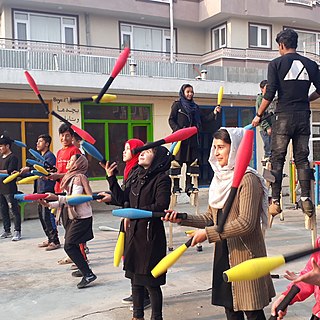
Juggling is a physical skill, performed by a juggler, involving the manipulation of objects for recreation, entertainment, art or sport. The most recognizable form of juggling is toss juggling. Juggling can be the manipulation of one object or many objects at the same time, most often using one or two hands but other body parts as well, like feet or head. Jugglers often refer to the objects they juggle as props. The most common props are balls, clubs, or rings. Some jugglers use more dramatic objects such as knives, fire torches or chainsaws. The term juggling can also commonly refer to other prop-based manipulation skills, such as diabolo, plate spinning, devil sticks, poi, cigar boxes, contact juggling, hooping, yo-yo, hat manipulation and kick-ups.
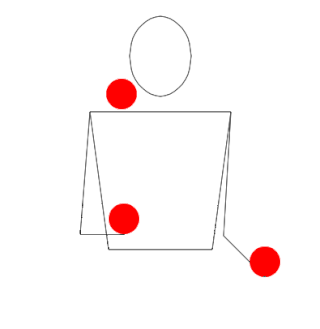
In toss juggling, a cascade is the simplest juggling pattern achievable with an odd number of props. The simplest juggling pattern is the three-ball cascade, This is therefore the first pattern that most jugglers learn. However, although the shower requires more speed and precision, "some people find that the movement comes naturally to them," and it may be the pattern learned first. "Balls or other props follow a horizontal figure-eight [or hourglass figure] pattern above the hands." In siteswap, each throw in a cascade is notated using the number of balls; thus a three ball cascade is "3".
In the cascade, an object is always thrown from a position near the body's midline in an arc passing underneath the preceding throw and toward the other side of the body, where it is caught and transported again toward the body's midline for the next throw. As a result, the balls travel along the figure-eight path that is characteristic of the cascade.

Siteswap, also called quantum juggling or the Cambridge notation, is a numeric juggling notation used to describe or represent juggling patterns. The term may also be used to describe siteswap patterns, possible patterns transcribed using siteswap. Throws are represented by non-negative integers that specify the number of beats in the future when the object is thrown again: "The idea behind siteswap is to keep track of the order that balls are thrown and caught, and only that." It is an invaluable tool in determining which combinations of throws yield valid juggling patterns for a given number of objects, and has led to previously unknown patterns. However, it does not describe body movements such as behind-the-back and under-the-leg. Siteswap assumes that "throws happen on beats that are equally spaced in time."

Multiplexing is a juggling trick or form of toss juggling where more than one ball is in the hand at the time of the throw. The opposite, a squeeze catch, is when more than one ball is caught in the hand simultaneously on the same beat. If a multiplex throw were time-reversed, it would be a squeeze catch.

In toss juggling, Mills' Mess is a popular juggling pattern, typically performed with three balls although the props used and the number of objects can be different. The pattern was invented by and named after Steve Mills. It is a well-known trick among jugglers and learning it is considered somewhat of a milestone, "a mind-boggling pattern of circling balls, crossing and uncrossing hands, and unexpected catches."

Juggling clubs are a prop used by jugglers. Juggling clubs are often simply called clubs by jugglers and sometimes are referred to as pins or batons by non-jugglers. Clubs are one of the three most popular props used by jugglers; the others being balls and rings.
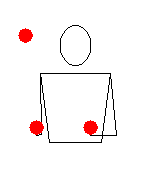
In toss juggling, the box is a juggling pattern for 3 objects, most commonly balls or bean bags. Two balls are dedicated to a specific hand with vertical throws, and the third ball is thrown horizontally between the two hands. Its siteswap is (4,2x)(2x,4).

In toss juggling, a flash is either a form of numbers juggling where each ball in a juggling pattern is only thrown and caught once or it is a juggling trick where every prop is simultaneously in the air and both hands are empty.
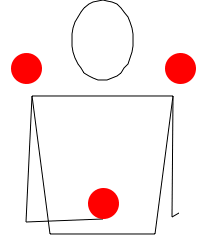
In toss juggling, columns, also known as One-up Two-up, is a juggling trick or pattern where the balls are thrown upwards without any sideways motion, distinguishing it from the fountain. The simplest version involves having three balls, with two going up simultaneously on either side, followed by one going up in the middle. One way to accomplish this is to juggle 2 balls in one hand and one ball in the other, so one hand has to move faster and further than in a regular pattern (cascade), whilst the other remains almost stationary. The hand juggling the center ball can alternate with each repeat to make the pattern symmetric.
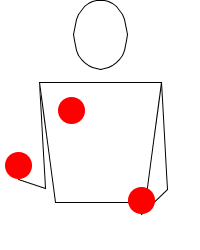
In toss juggling, Rubenstein's Revenge is a 3-ball juggling pattern named by George Gillson after its inventor, Rick Rubenstein. Along with Mills' Mess and Burke's Barrage, it is one of three well-known named juggling patterns that involve complex carries and crossed arm throws. Rubenstein's Revenge is usually considered the most involved and difficult of the three.

Toss juggling is the form of juggling which is most recognisable as 'juggling'. Toss juggling can be used as: a performing art, a sport, a form of exercise, as meditation, a recreational pursuit or hobby.
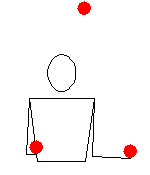
In toss juggling, the shower is a juggling pattern for 3 or more objects, most commonly balls or bean bags, where objects are thrown in a circular motion. Balls are thrown high from one hand to the other while the other hand passes the ball back horizontally. "In the shower pattern, every ball is thrown in a high arc from the right hand to the left and then quickly passed off with a low throw from the left to the right hand ." The animation depicts a 3-ball version. Siteswap notation for shower patterns is (2n-1)1, where n is the number of objects juggled. The circular motion of the balls is commonly represented in cartoons as the archetypical juggling pattern, somewhat at odds with reality, where the cascade is more common. By constantly reversing the direction, the box pattern can be formed.
Juggling practice has developed a wide range of patterns and forms which involve different types of manipulation, different props, numbers of props, and numbers of jugglers. The forms of juggling shown here are practiced by amateur, non-performing, hobby jugglers as well as by professional jugglers. The variations of juggling shown here are extensive but not exhaustive as juggling practice develops and creates new patterns on a regular basis. Jugglers do not consciously isolate their juggling into one of the categories shown; instead most jugglers will practice two or more forms, combining the varieties of juggling practice. Some forms are commonly mixed, for example: numbers and patterns with balls; while others are rarely mixed, for example: contact numbers passing. Many Western jugglers also practice other forms of object manipulation, such as diabolo, devil sticks, cigar box manipulation, fire-spinning, contact juggling, hat manipulation, poi, staff-spinning, balancing tricks, bar flair and general circus skills.

Juggling world records comprise the best performances in the fields of endurance and numbers juggling.

Juggling notation is the written depiction of concepts and practices in juggling. Toss juggling patterns have a reputation for being "easier done than said" – while it might be easy to learn a given maneuver and demonstrate it for others, it is often much harder to communicate the idea accurately using speech or plain text. To circumvent this problem, various numeric or diagram-based notation systems have been developed to facilitate communication of patterns or tricks between jugglers, as well the investigation and discovery of new patterns.

Juggling balls, or simply balls, are a popular prop used by jugglers, either on their own—usually in sets of three or more—or in combination with other props such as clubs or rings. A juggling ball refers to any juggling object that is roughly spherical in nature.

Juggling rings, or simply "rings", are a popular prop used by jugglers, usually in sets of three or more, or in combination with other props such as balls or clubs. The rings used by jugglers are typically about 30 centimetres (12 in) in diameter and 3 millimetres (0.12 in) thick.

A juggling pattern or juggling trick is a specific manipulation of props during the practice of juggling. "Juggling, like music, combines abstract patterns and mind-body coordination in a pleasing way." Descriptions of patterns and tricks have been most common in toss juggling. A juggling pattern in toss juggling is a sequence of throws and catches using a certain number of props which is repeated continuously. Patterns include simple ones such as the cascade and complex ones such as Mills mess. A juggling trick in toss juggling is a throw or catch which is different from the throws and catches within a pattern. Tricks include simple ones such as a high throw or more difficult ones such a catch on the back of the jugglers neck, as well as the claw, multiplex, and pass. Systems of juggling notation have been created to describe juggling patterns and tricks. One of these is siteswap notation.
Juggling terminology, juggling terms: